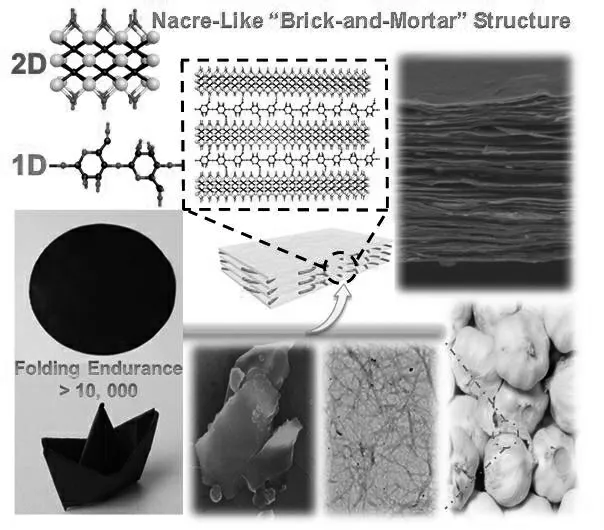Binary Strengthening and Toughening of Mxene/Cellulose Nanofiber Composite Paper with Nacre-Inspired Structure and Superior Electromagnetic Interference Shielding Properties
CAO Wentao, CHEN Feifei, ZHU Yingjie*, ZHANG Yonggang, JIANG Yingying,MA Mingguo, CHEN Feng*
(1. Beijing Key Laboratory of Lignocellulosic Chemistry, College of Materials Science and Technology, Beijing Forestry University, Beijing 100083, China;2. State Key Laboratory of High Performance Ceramics and Superfine Microstructure, Shanghai Institute of Ceramics, Chinese Academy of Sciences, Shanghai 200050, China)*Corresponding E-mail: y.j.zhu@mail.sic.ac.cn; mg_ma@bjfu.edu.cn; fchen@tongji.edu.cn
Key words: cellulose nanofibers; electromagnetic interference shielding; mechanical properties; MXene; paper
In the past decades, the use of wireless communication and electronic devices has become an increasingly common phenomenon with economic development. However, electromagnetic radiation is emitted inevitably by the electronic devices, which not only affects the normal function and the lifetime of the electronic instruments but also is harmful to human health. Thus, electromagnetic interference (EMI) shielding materials with good performances are urgently required to resolve the above-mentioned problems. Traditional metal shielding materials exhibit excellent EMI shielding performance. Nevertheless, intrinsic high density and susceptibility to corrosion in the harsh environment limit their applications. Recently, many carbon-based materials(e.g., graphene, reduced graphene oxide, carbon nanotubes) were reported and regarded as alternatives for EMI shielding applications owing to their low density and corrosion resistance.
MXenes, two-dimensional (2D) nanomaterials, are produced by selectively etching the A-element from ternary transition metal carbides with a general formula of Mn+1AXn, where M is an early transition metal, A represents a group of XIII and XIV elements, and X is C and/or N. Due to the large specific surface area and high electrical conductivity, MXenes exhibit lightweight and superior EMI shielding performance. The MXene materials possess an EMI shielding performance better than that of many metal and carbon-based materials. However, the unsatisfied mechanical properties of MXene materials limit their applications in wearable electronic devices, weapon equipment, and robot joints, which need to be strong to endure mechanical deformation.
As the most abundant and renewable natural polymer on Earth, cellulose seems to be inexhaustible for all time. Cellulose nanofibers (CNFs), which can be derived from cellulose, are often used as a reinforcement material for composites owing to their high mechanical strength and great flexibility. More importantly, compared with other polymers, CNFs have a characteristic one-dimensional(1D) nanofiber structure, which will lead to less insulating contacts between 2D conductive nanosheets. In recent years, it was reported that CNFs could be integrated with graphene, reduced graphene oxide, and carbon nanotubes for applications in energy storage such as Li-ion batteries, Na-ion batteries, and supercapacitors. However, to the best of our knowledge, there is no relevant report on the d-Ti3C2Tx/CNF composite paper for the EMI shielding application. Therefore, it is of great significance to prepare the d-Ti3C2Tx/CNF composite paper with enhanced mechanical properties and EMI shielding performance.
In this study, an ultrathin and flexible d-Ti3C2Tx/CNF composite paper constructed with 1D CNFs and 2D delaminated Ti3C2Txnanosheets has been successfully prepared by a facile vacuum-assisted filtration self-assembly method.
The d-Ti3C2Tx/CNF composite paper exhibits a nacre-like microstructure and excellent mechanical properties. The ultimate tensile strength and strain are up to 135.4 MPa and 16.7%, respectively, and the bending number in the folding endurance test is up to 14 260 times. Moreover, the d-Ti3C2Tx/CNF composite paper also exhibits superior electrical conductivity and EMI shielding efficiency. The d-Ti3C2Tx/CNF composite paper with a nacre-like structure and excellent mechanical properties has promising applications in flexible electronics such as wearable electric devices, weapon equipment, and robot joints.


